The Stamford Historical Society Presents
Pride and Patriotism: Stamford’s Role in World War II
Online Edition
The Interviews
Bob Rodwin
Bob Rodwin was drafted into the service in 1942. He initially served as an MP guarding military ships on the docks in Philadelphia but was later transferred to the 755th Railroad Shop Battalion where he served as company clerk. He went over to Europe with that outfit in 1945. Following the war’s conclusion he was transferred to Patton’s 15th Army Transportation Corps.
Bob Rodwin also loaned the book Fifteenth Army Group History, 16 December, 1944 - 2 May, 1945 (Combat Arms Series) for the exhibit, and a several maps from it are shown in the exhibit.
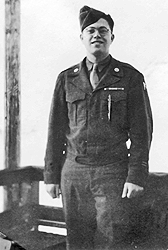 I was going to Northwestern University in Evanston, Illinois in 1940. I had a friend named Roko Yasuwe. We met in the fall of 1940. He was from the West Coast and had been born here. He was of Japanese ancestry. We spent a lot of time together. He was in Engineering and I was in Journalism.
I was going to Northwestern University in Evanston, Illinois in 1940. I had a friend named Roko Yasuwe. We met in the fall of 1940. He was from the West Coast and had been born here. He was of Japanese ancestry. We spent a lot of time together. He was in Engineering and I was in Journalism.
I went back to school in September 1941 and we didn’t see as much of each other. People of my dorm said derogatory things about him, so we wouldn’t meet at dorm, but we would do things outside of dorm…December 7 I was at Deering Library studying, when I heard a commotion, cat calls, etc. People were saying we were at war with the Japs. Many wanted to enlist right off…people were filled with fear, panic, elation. President Roosevelt gave his speech: A day that will live in infamy…
Roko Yasuwe disappeared off campus. I never found out what happened to him.
On January 7, 1943 I entered the service, signing myself in, the draft board made it clear I would be drafted anyway. I reported to Camp Upton Yaphank, New York, the old World War I camp…I stayed there in tents with pot bellied stoves to keep warm, it was January ‘43. I was only there seven days, then I went to Camp Kilmer in New Jersey for basic training in a military police battalion. I was put through paces, bayonet training, movies on why we fight made by Frank Capra, etc. We also looked at films on battle wounds. MP training included grenades, crawling around, etc., PA machine gun, infiltration training.
Gas tests, gas masks etc. I had duty in New Brunswick, New Jersey…I had to get guys back to camp after a night out. After that I was sent to Philadelphia to work in the cargo port.
It was a tremendous loading facility before war…victory ships came in one side and military ships were in the center of the pier. There were guards from head to end of pier in Delaware River. I saw a lot of stuff going aboard and had a pretty good idea of the coming invasion based on quantity of stuff going over. We guarded the deck cargo and in the holds…we went down to make sure stevedores weren’t smoking or stealing… This went on for a while.
One night I was on the last post on the Delaware and an officer came on a Jeep out to check…I was covered behind a post and called halt who goes there…advance and be recognize. The officer was shaken up but pleased.
After that I went to Camp Plochet in Slidell, Louisiana outside of New Orleans…they were forming a railway shop battalion, out of the MPs now…I didn’t know anything about this at all. The Lieutenant put a desk in the middle of the barrack and I became a company clerk, because I had no railroad experience and there were lots of records to do… 755th RR Shop Battalion.
Then I went to Bucyrus, Ohio…a crossroads railroad shop, I was working with guys in the orderly room with a tough Sergeant...He would take all the stuff my mom sent from home.
Then I was sent to Camp Shenks, New York and processed there. I left from Pier 84 at North River…they always used it for liners, but now it was military. On March 23, ‘45 I went aboard a US Army transport called the Cristobal. It was a Panama-Pacific Line ship weighing 14,000 tons. I was in a hammock deep down below the water level near an exit.
We had daily drills…a voice would say, “You guys in compartment 4 better move fast if we have any action”…
We did have an accident: at 2 AM in a heavy fog in March we rammed a Navy seagoing tanker with high octane fuel, if we hit 14 feet further up we would have been dead. We thought we had been torpedoed. We were going over in convoy and a general alarm went off, and all got up to top deck, put life jackets on. We were 8 days out of New York in the middle of the Atlantic. We hit aft in the tanker and 4 guys got killed, there were no injuries on Cristobal. Convoys had to zigzag.
We landed safely Southampton, England. We transferred to another boat, then went up the Seine River in France to 20 Grand, they used cigarette names for camps then…20 Grand was staffed by German POWs. It was late March of 1945. I stayed there for a while and got acclimated.
We didn’t know where we were going, but were marched to a railhead, put on a train in boxcars 40 and 8s from World War I, and rode for 2 1/2 days through France, slowly…We saw a lot of the damage, destruction of farmhouses, people waving, looking for food. I was still part of the Railroad Shop Battalion, Transportation Corps. We landed in Strasbourg in Bas-Rhin….4 km from the front and billeted near the Rhine River in a church parish house. We had the gymnasium, and slept on the floor in sleeping bags. There was a lot of noise…planes, shells etc…we stayed there. We didn’t captured people but we did see dead Germans.
We were still there in Bas-Rhin when the war ended, it was just the two clerks, me and the other guy, and we had weapons, though we never used them. Earlier on we had Enfields and Springfields, then finally carbines. We were charged with guarding the ammo boxes…the guys had carbines but we had all the ammo.
I ended up in Belgium. I was still in the Railroad Shop Battalion. We were still near Liege. It gave us the chance to look around, then I was sent to the HQ of the 15th Army in Bad Nauheim. That was the outfit Patton was put in. Germany. I was taken out of RR battalion at that point. We were doing research, statistics for methods of transportation as the 15th was part of Transportation Corps. It was Patton’s last command. We always saluted the car.
I had an experience with Patton, I was taking papers from HQ to the hotel he was staying in and a friend had warned me I might run into Patton…I heard a commotion on the stairs and Patton came down, I was at attention and scared. He was carrying a riding crop and pearl handled pistols. I was at attention…he glowered. He said, “At ease soldier.” and went past. I was relieved.
We had a point system for getting sent home. I was sent to Berlin and met guys from the Railroad Corps. They were servicing cars from Hitler's train that had been hidden all over the country. It became Ike’s train. We stayed there a few weeks, I was supposed to support to motor pool but the sergeant sent me away, as there was nothing to do…so I went to the library to read books (special services), got passes to go to the other zones in Berlin. Shortly thereafter, I got sent home.
Namur, Belgium
Biselsheim, France
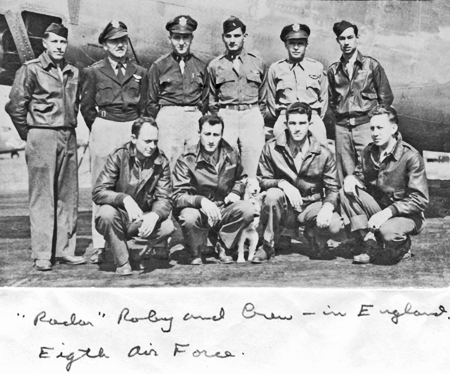
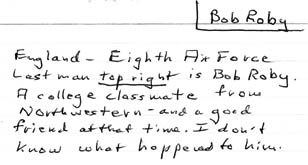
Photos Courtesy Bob Rodwin
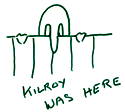 back to top
back to top
Introduction
Veterans
Battles
Stamford Service Rolls
Homefront
Exhibit Photos
Opening Day


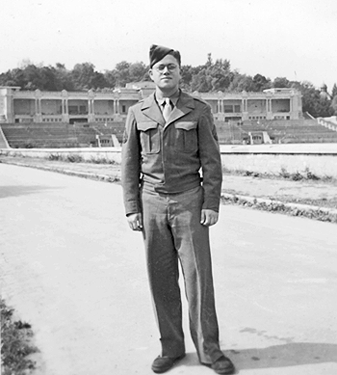
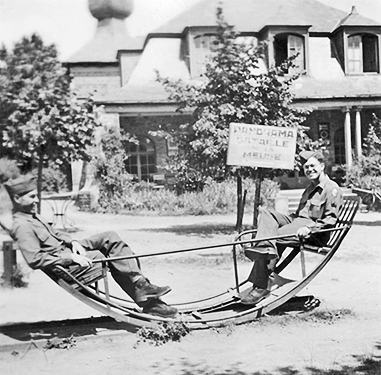
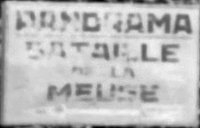
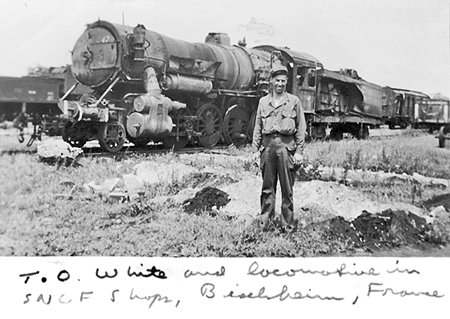
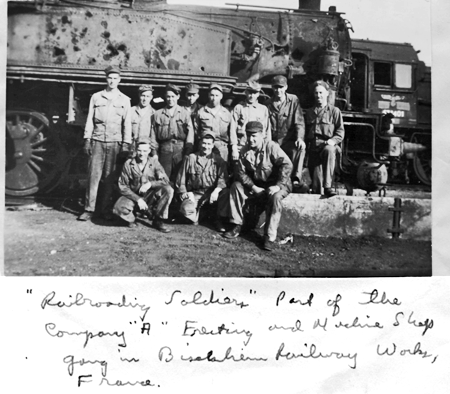


 I was going to Northwestern University in Evanston, Illinois in 1940. I had a friend named Roko Yasuwe. We met in the fall of 1940. He was from the West Coast and had been born here. He was of Japanese ancestry. We spent a lot of time together. He was in Engineering and I was in Journalism.
I was going to Northwestern University in Evanston, Illinois in 1940. I had a friend named Roko Yasuwe. We met in the fall of 1940. He was from the West Coast and had been born here. He was of Japanese ancestry. We spent a lot of time together. He was in Engineering and I was in Journalism.